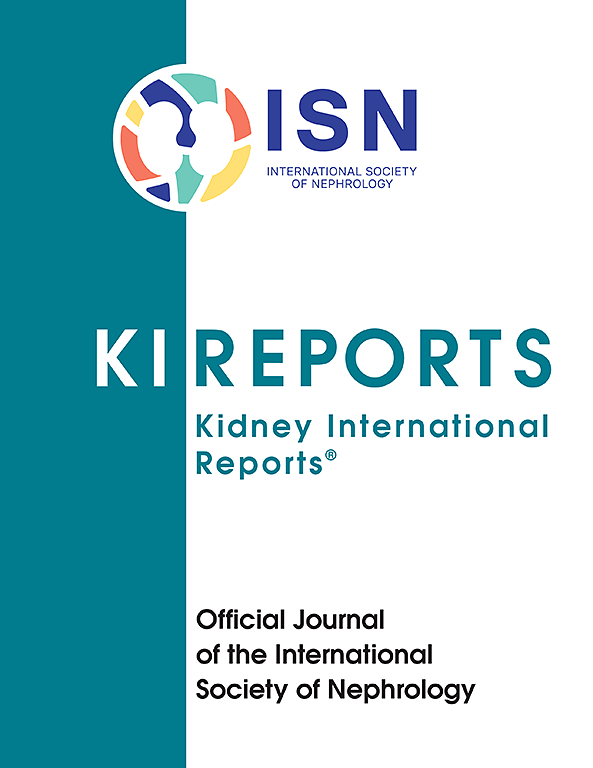口服直接Xa因子抑制剂对肾病综合征患者的安全性和有效性:一项全国性回顾性研究的结果
IF 5.7
2区 医学
Q1 UROLOGY & NEPHROLOGY
引用次数: 0
摘要
肾病综合征(NS)患者血栓栓塞(TE)的最佳管理仍然具有挑战性。到目前为止,NS的抗凝治疗包括维生素K拮抗剂(VKAs)或肝素。直接口服抗凝剂(DOAC)用于NS的数据有限,其安全性和便利性已在其他适应症中得到很好的证明。方法对2014年至2022年接受治疗剂量抗凝治疗的成年NS患者进行多中心回顾性研究。我们比较了接受DOAC和接受vka或肝素(标准治疗[SOC])的患者出血和TE事件的发生率。排除了终末期肾病患者。结果144例患者(中位年龄为54[38-67]岁,34.7%为女性),中位白蛋白水平为1.5 (1.2-1.8)g/ dl,中位尿蛋白/肌酐比值为8.8 (5.5-12.3)g/g。膜性肾病是NS的主要病因(45.8%)。DOAC组(n = 72)和SOC组(n = 72)之间无显著差异。79.2%的DOAC患者和83.3%的SOC患者的抗凝策略是一级预防(P = 0.67)。与SOC组相比,DOAC的使用与TE发生率(4.2% vs. 0%, P = 0.25)或出血事件(6.9% vs. 13.9%, P = 0.28)的增加无关。单因素分析确定女性性别、年龄;75岁,抗凝剂暴露>;90天是出血的危险因素。结论在NS患者的一级和二级预防中,DOAC比常规抗凝策略更安全、更有效。本文章由计算机程序翻译,如有差异,请以英文原文为准。

Safety and Efficacy of Oral Direct Factor Xa Inhibitors in Patients With Nephrotic Syndrome: Results From a National Retrospective Study
Introduction
The optimal management of thromboembolism (TE) in patients with nephrotic syndrome (NS) remains challenging. Until now, anticoagulation therapy for NS consisted of vitamin K antagonists (VKAs) or heparin. Data on direct oral anticoagulant (DOAC) use in NS are limited, and their safety and convenience have been well-demonstrated in other indications.
Methods
We conducted a multicenter retrospective study of adult patients with NS treated with therapeutic-dose anticoagulation between 2014 and 2022. We compared the incidences of bleeding and TE events between patients receiving DOAC and those receiving VKAs or heparin (standard-of-care [SOC]). Patients with end-stage kidney disease were excluded.
Results
The overall population consisted of 144 patients (median [interquartile range] age of 54 [38–67] years, 34.7% women) with a median albumin level at 1.5 (1.2–1.8) g/dl and a median urinary protein-to-creatinine ratio of 8.8 (5.5–12.3)g/g. Membranous nephropathy was the main NS etiology (45.8%). No significant differences were observed between the DOAC (n = 72) and the SOC (n = 72) groups. The anticoagulant strategy was primary prophylaxis in 79.2% of patients taking DOAC and 83.3% of patients with SOC (P = 0.67). DOAC use was not associated with an increased rate of TE (4.2% vs. 0%, P = 0.25) or bleeding events (6.9% vs. 13.9%, P = 0.28) compared with the SOC group. Univariate analysis identified female sex, age > 75 years, and anticoagulant exposure > 90 days as risk factors for bleeding.
Conclusion
This study suggests that DOAC are safer and more effective than conventional anticoagulant strategies for both primary and secondary prophylaxis in patients with NS.
求助全文
通过发布文献求助,成功后即可免费获取论文全文。
去求助
来源期刊

Kidney International Reports
Medicine-Nephrology
CiteScore
7.70
自引率
3.30%
发文量
1578
审稿时长
8 weeks
期刊介绍:
Kidney International Reports, an official journal of the International Society of Nephrology, is a peer-reviewed, open access journal devoted to the publication of leading research and developments related to kidney disease. With the primary aim of contributing to improved care of patients with kidney disease, the journal will publish original clinical and select translational articles and educational content related to the pathogenesis, evaluation and management of acute and chronic kidney disease, end stage renal disease (including transplantation), acid-base, fluid and electrolyte disturbances and hypertension. Of particular interest are submissions related to clinical trials, epidemiology, systematic reviews (including meta-analyses) and outcomes research. The journal will also provide a platform for wider dissemination of national and regional guidelines as well as consensus meeting reports.
 求助内容:
求助内容: 应助结果提醒方式:
应助结果提醒方式:


